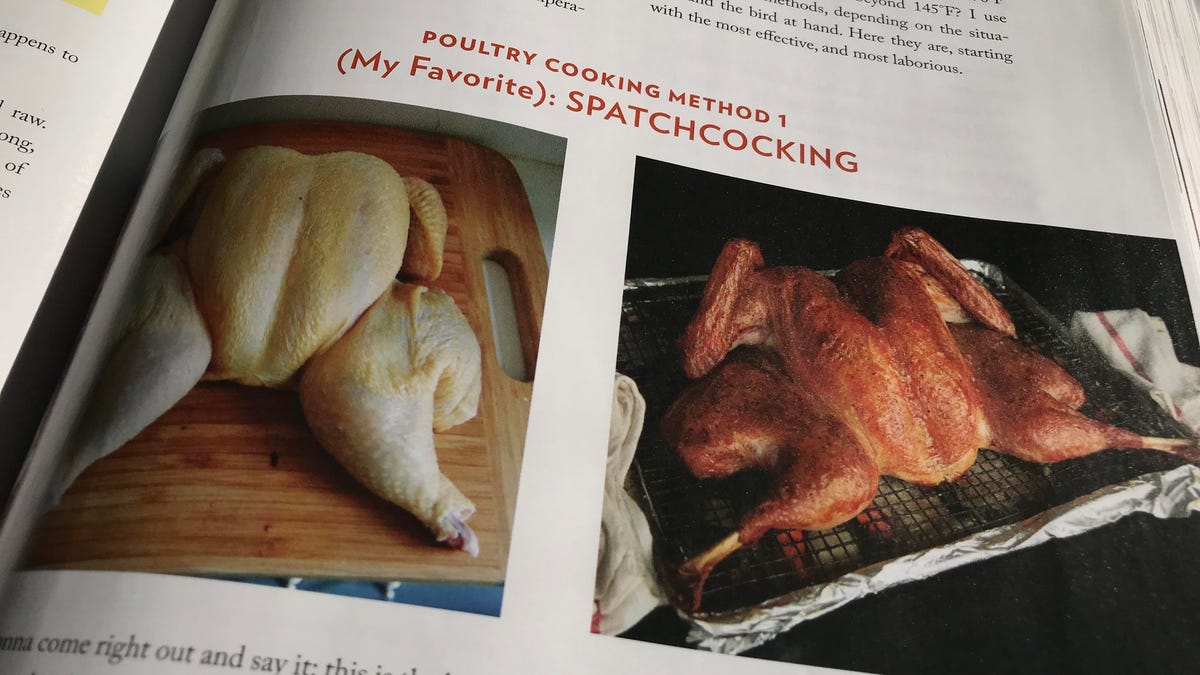 Why You Can Trust CNET
Why You Can Trust CNET The best way to roast a turkey
Welcome to your spatchcocking primer.

Last year, upon my brother's urging, I spatchcocked my Thanksgiving turkey. My first turkey spatchcocking required a bit of up-front work (cutting out the backbone and purchasing a large jellyroll pan and wire rack), but I made up that work on the backend because it greatly reduced the cooking time and made carving the bird much easier. Most importantly, spatchcocking resulted in a delicious turkey -- juicy meat and crispy skin -- being placed at the center of our Thanksgiving table.
My brother and I aren't the only spatchcock fans out there. In his book, The Food Lab, J. Kenji Lopez-Alt says spatchcocking is "the best way to cook a bird, hands down. It's now the only method I ever use."
Spatchwhat?
Spatchcocking is just a fun word for butterflying. You cut out the backbone from the bird and then flatten it out. With the backbone removed, you lay the turkey out flat on a big, rimmed baking sheet and pop it in the oven.
Lopez-Alt identifies five advantages of spatchcocking:
Even cooking
With its flat shape, the meat cooks more evenly than a whole bird, where the breast meat cooks faster than the dark meat because the legs and thighs are protected in your roasting pan. With the bird lying flat, the legs and thighs cook faster and finish cooking before the breast meat dries out.
Juicer meat and crisper skin
With all the skin facing up and not hiding underneath the bird and inside the roasting pan, all of the skin gets crispy. No more soggy skin on your turkey thighs! And all of that crispy skin renders fat over the meat, which helps keep it from drying out.
Faster cooking
Cooking a big sphere of meat -- a whole turkey -- is inefficient because it takes a long time for heat to penetrate through to its center. With the slim profile of a spatchcocked turkey, you can cook it in a hotter oven for about half the time it would take to cook the bird all big and round.
Easier carving
It's hard to wrestle with a big turkey on a carving board. With it lying flat, it means no more rotating and angling the bird to carve it.
Better gravy
If you make your gravy with the neck that you find inside the cavity of the bird, then you know that using bones makes better gravy. With the bird's backbone added to the equation, your gravy will be even better.
In summary, spatchcocking results in juicier turkey, with crispier skin that cooks faster and carves easier, and makes better gravy.
OK, how do I spatchcock a turkey?
Put your turkey on a cutting board, breast-side down. Get a pair of poultry or kitchen shears and cut down one side of the backbone and then repeat on the other side. To make the bird easier to carve, you can take a paring knife and cut out the wishbone, but it's not necessary. With the backbone removed, flip the bird over and push down hard on the breast bone to crack it so the bird lies flat.
Check out this spatchcocking video from Lopez-Alt for step-by-step instructions, from preparation and roasting to carving and gravy-making:
How do I cook a spatchcocked turkey?
Get yourself a big, rimmed baking sheet -- a jelly-roll pan -- and line it with foil. You'll also need a wire rack that fits inside it. Line the baking sheet with chopped onions, carrots and celery along with a few sprigs of thyme and bay leaves. The veggies will release moisture and help prevent the drippings from burning; you'll want the drippings for your gravy.
Put the wire rack on top of the veggies and then put the bird, skin side up, on the rack. Salt and pepper the bird and pop it in a 450-degree oven and set a timer for 75 minutes. When the oven beeps, use a meat thermometer to check the breast meat. Lopez-Alt says it's done when it hits 150 degrees, which is below the USDA's recommendation of 165 degrees for a turkey being safely done. But that's your window: 150 to 165 degrees.
Are there any disadvantages?
Three that I count:
You'll need a big baking sheet
If you're cooking for a big table and are cooking a huge turkey, then it might hang over the sheet and make a mess of your oven. You could, of course, cook two smaller turkeys for a big crowd. Since they lie flat, you can probably get both in the oven at the same time.
No stuffing inside the bird
I love stove-top stuffing, so this isn't an issue for me, but if you make your stuffing inside the cavity of your bird, then that's obviously not an option if it's been flattened.
Not as Instagram-worthy
A spatchcocked turkey doesn't create as pretty a picture when it comes out of the oven as a whole roasted bird, but I'd rather have the better tasting turkey than the better looking turkey, if given the choice.
For more Thanksgiving tips, learn how to defrost a turkey and how to brine a turkey.
Originally published on Nov. 21, 2017.
Update, Nov. 15, 2018: Adding information about my spatchcock experience from last year.
Black Friday deals: See every Black Friday 2018 deal we've found so far.
Holiday Gift Guide: CNET's full gift guide, including dozens of products priced under $25, $50 and $100.

